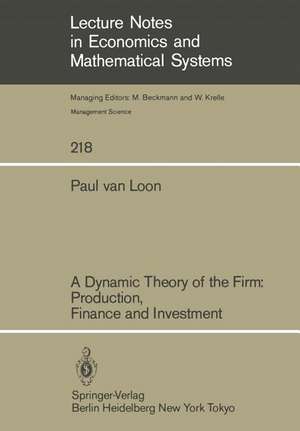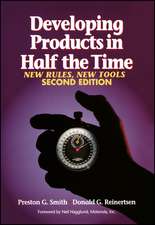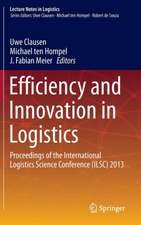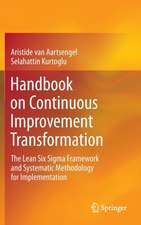A Dynamic Theory of the Firm: Production, Finance and Investment: Lecture Notes in Economics and Mathematical Systems, cartea 218
Autor Paul Van Loonen Limba Engleză Paperback – aug 1983
Din seria Lecture Notes in Economics and Mathematical Systems
-
 Preț: 360.02 lei
Preț: 360.02 lei -
 Preț: 383.93 lei
Preț: 383.93 lei - 15%
 Preț: 693.39 lei
Preț: 693.39 lei -
 Preț: 384.09 lei
Preț: 384.09 lei -
 Preț: 380.07 lei
Preț: 380.07 lei -
 Preț: 446.26 lei
Preț: 446.26 lei -
 Preț: 497.37 lei
Preț: 497.37 lei -
 Preț: 380.84 lei
Preț: 380.84 lei -
 Preț: 384.86 lei
Preț: 384.86 lei -
 Preț: 378.34 lei
Preț: 378.34 lei -
 Preț: 399.67 lei
Preț: 399.67 lei - 20%
 Preț: 360.93 lei
Preț: 360.93 lei - 15%
 Preț: 643.16 lei
Preț: 643.16 lei -
 Preț: 379.09 lei
Preț: 379.09 lei -
 Preț: 404.76 lei
Preț: 404.76 lei -
 Preț: 385.62 lei
Preț: 385.62 lei - 15%
 Preț: 644.49 lei
Preț: 644.49 lei -
 Preț: 379.09 lei
Preț: 379.09 lei -
 Preț: 345.50 lei
Preț: 345.50 lei -
 Preț: 425.80 lei
Preț: 425.80 lei -
 Preț: 378.34 lei
Preț: 378.34 lei - 18%
 Preț: 775.65 lei
Preț: 775.65 lei -
 Preț: 392.60 lei
Preț: 392.60 lei -
 Preț: 401.61 lei
Preț: 401.61 lei - 15%
 Preț: 646.43 lei
Preț: 646.43 lei -
 Preț: 382.18 lei
Preț: 382.18 lei -
 Preț: 378.34 lei
Preț: 378.34 lei - 15%
 Preț: 637.59 lei
Preț: 637.59 lei - 15%
 Preț: 647.27 lei
Preț: 647.27 lei -
 Preț: 377.73 lei
Preț: 377.73 lei -
 Preț: 447.84 lei
Preț: 447.84 lei - 15%
 Preț: 644.49 lei
Preț: 644.49 lei -
 Preț: 386.00 lei
Preț: 386.00 lei - 15%
 Preț: 654.43 lei
Preț: 654.43 lei -
 Preț: 415.02 lei
Preț: 415.02 lei -
 Preț: 411.54 lei
Preț: 411.54 lei -
 Preț: 398.92 lei
Preț: 398.92 lei -
 Preț: 398.92 lei
Preț: 398.92 lei -
 Preț: 392.75 lei
Preț: 392.75 lei - 15%
 Preț: 635.47 lei
Preț: 635.47 lei - 20%
 Preț: 653.56 lei
Preț: 653.56 lei -
 Preț: 379.86 lei
Preț: 379.86 lei -
 Preț: 495.46 lei
Preț: 495.46 lei -
 Preț: 447.99 lei
Preț: 447.99 lei -
 Preț: 378.71 lei
Preț: 378.71 lei - 15%
 Preț: 637.13 lei
Preț: 637.13 lei -
 Preț: 385.84 lei
Preț: 385.84 lei -
 Preț: 378.54 lei
Preț: 378.54 lei - 15%
 Preț: 666.55 lei
Preț: 666.55 lei
Preț: 384.48 lei
Nou
Puncte Express: 577
Preț estimativ în valută:
73.58€ • 79.90$ • 61.81£
73.58€ • 79.90$ • 61.81£
Carte tipărită la comandă
Livrare economică 22 aprilie-06 mai
Preluare comenzi: 021 569.72.76
Specificații
ISBN-13: 9783540126782
ISBN-10: 3540126783
Pagini: 204
Ilustrații: VII, 194 p.
Dimensiuni: 170 x 244 x 11 mm
Greutate: 0.33 kg
Ediția:Softcover reprint of the original 1st ed. 1983
Editura: Springer Berlin, Heidelberg
Colecția Springer
Seria Lecture Notes in Economics and Mathematical Systems
Locul publicării:Berlin, Heidelberg, Germany
ISBN-10: 3540126783
Pagini: 204
Ilustrații: VII, 194 p.
Dimensiuni: 170 x 244 x 11 mm
Greutate: 0.33 kg
Ediția:Softcover reprint of the original 1st ed. 1983
Editura: Springer Berlin, Heidelberg
Colecția Springer
Seria Lecture Notes in Economics and Mathematical Systems
Locul publicării:Berlin, Heidelberg, Germany
Public țintă
ResearchCuprins
1. Introduction.- 1. Scope of the book.- 2. Outline of the book.- 3. Relevance of dynamic theories of the firm.- 4. Origins of dynamic theories of the firm.- 5. Nature of the theory of the firm and of this book.- 6. Summary.- 2. A Survey of Dynamic Theories of the Firm.- 1. Introduction.- 2. Shareholders.- 3. Management.- 4. Employees.- 5. Labour Market.- 6. Output Market.- 7. Competitors.- 8. Lenders of debt money.- 9. Suppliers of assets.- 10. Government.- 11. Macro economic data.- 12. Summary.- 3. Some Predecessors.- 1. Introduction.- 2. Investments and depreciation (Jorgenson).- 3. Production and finance I (Leland).- 4. Finance and the value of the firm (Ludwig).- 5. Production and finance II (Lesourne & Leban).- 6. Summary.- 4. A Dynamic Model of the Firm.- 1. Introduction.- 2. Production.- 3. Sales and operating income.- 4. Financing and government.- 5. Policy of the firm.- 6. The model.- 7. Further assumptions.- 8. Optimal solution.- 9. Summary.- 5. Optimal Trajectories of the Firm.- 1. Introduction.- 2. Basic trajectory.- 3. Depth investments.- 4. Consolidation.- 5. Depth investments and consolidation.- 6. Summary.- 6. A Further Analysis.- 1. Introduction.- 2. Optimal decision rules.- 3. Environmental influence on the trajectory of the firm.- 4. Influence of (sets of) environmental parameters.- 5. Summary.- 7. Conclusions.- Appendix 1. An Interpretation of the Maximum Principle.- 1. Introduction.- 2. Technical terms.- 3. The Maximum Principle of Pontryagin.- 4. Mixed control constraints.- 5. State constraints.- 6. Summary.- Appendix 2. Solutions of the Models of Chapter 3.- 1. Introduction.- 2. A general solution procedure.- 3. The model of Jorgenson.- 4. The model of Ludwig.- 5. The model of Lesourne & Leban.- 6. Summary.- Appendix 3. Solution of the Model of Chapter 4.- 1. A reduced form of the model.- 2. Optimality conditions.- 3. A reduced form of the optimality conditions.- 4. Infeasible paths.- 5. Feasible paths.- 6. Final paths.- 7. Coupling conditions.- 8. Coupling procedure.- 9. Summary.- List of Symbols.- References.- Author Index.











